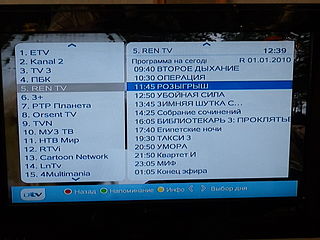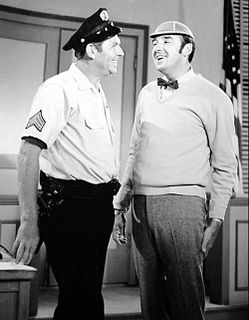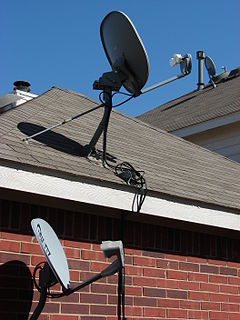Related Research Articles

Cable television is a system of delivering television programming to consumers via radio frequency (RF) signals transmitted through coaxial cables, or in more recent systems, light pulses through fibre-optic cables. This contrasts with broadcast television, in which the television signal is transmitted over-the-air by radio waves and received by a television antenna attached to the television; or satellite television, in which the television signal is transmitted over-the-air by radio waves from a communications satellite orbiting the Earth, and received by a satellite dish antenna on the roof. FM radio programming, high-speed Internet, telephone services, and similar non-television services may also be provided through these cables. Analog television was standard in the 20th century, but since the 2000s, cable systems have been upgraded to digital cable operation.

A television channel is a terrestrial frequency or virtual number over which a television station or television network is distributed. For example, in North America, "channel 2" refers to the terrestrial or cable band of 54 to 60 MHz, with carrier frequencies of 55.25 MHz for NTSC analog video (VSB) and 59.75 MHz for analog audio (FM), or 55.31 MHz for digital ATSC (8VSB). Channels may be shared by many different television stations or cable-distributed channels depending on the location and service provider

The primary regulator of communications in the United States is the Federal Communications Commission. It closely regulates all of the industries mentioned below with the exception of newspapers and the Internet service provider industry.

Coaxial cable, or coax is a type of electrical cable consisting of an inner conductor surrounded by a concentric conducting shield, with the two separated by a dielectric ; many coaxial cables also have a protective outer sheath or jacket. The term coaxial refers to the inner conductor and the outer shield sharing a geometric axis.

The American Forces Network (AFN) is a government television and radio broadcast service the U.S. military provides to those stationed or assigned overseas. Headquartered at Fort George G. Meade, Maryland, AFN's broadcast operations, which include global radio and television satellite feeds, emanate from the AFN Broadcast Center/Defense Media Center in Riverside, California. AFN was founded on 26 May 1942, in London as the Armed Forces Radio Service (AFRS).

Television is one of the major mass media outlets in the United States. As of 2011, household ownership of television sets in the country is 96.7%, with approximately 114,200,000 American households owning at least one television set as of August 2013. The majority of households have more than one set. The peak ownership percentage of households with at least one television set occurred during the 1996–97 season, with 98.4% ownership. In 1948, 1 percent of U.S. households owned at least one television while 75 percent did by 1955, and by 1992, 60 percent of all U.S. households received cable television subscriptions.
E! is an American basic cable channel which primarily focuses on pop culture, celebrity focused reality shows, and movies, owned by the NBCUniversal Television and Streaming division of NBCUniversal, a division of Comcast.
National Geographic is an American pay television network and flagship channel owned by the National Geographic Global Networks unit of Disney General Entertainment Content and National Geographic Partners, a joint venture between The Walt Disney Company (73%) and the National Geographic Society (27%), with the operational management handled by Walt Disney Television.
In cable television, governments apply a must-carry regulation stating that locally licensed television stations must be carried on a cable provider's system.

American Heroes Channel is an American multinational pay television channel owned by the Warner Bros. Discovery Networks unit of Warner Bros. Discovery. The network carries programs related to the military, warfare, and military history and science.

VH1 Uno was a digital cable and satellite television channel which was a sister channel of VH1. It featured a mix of Latin pop and ballads, tropical, salsa, merengue, tejano, Latin soul, reggaeton and urban hip hop, featuring top artists like Marc Anthony, Jennifer Lopez, Celia Cruz, Shakira and Luis Miguel.

DoD News Channel was a television channel broadcasting military news and information for the 2.6 million members of the U.S. Armed Forces. It was widely available in the United States as a standalone television channel, or as part of programming on local PEG cable television channels. It could be viewed FTA in most Central and Western European countries, Africa, the Americas and most of Asia via satellite, and globally via the Internet. DoD News Channel was free, in the public domain, and accessible 24/7 to all U.S. cable and satellite providers.
Cable television first became available in the United States in 1948. By 1989, 53 million U.S. households received cable television subscriptions, with 60 percent of all U.S. households doing so in 1992. with Data by SNL Kagan shows that as of 2006 about 58.4% of all American homes subscribe to basic cable television services. Most cable viewers in the U.S. reside in the suburbs and tend to be middle class; cable television is less common in low income, urban, and rural areas.

The Jim Nabors Hour is an American variety television series hosted by Jim Nabors that aired on the CBS television network from 1969 to 1971.
NorthSouth Productions is a television production company in the United States that was founded by Charlie DeBevoise and Mark Hickman in 2000. NorthSouth creates and produces original programming for a variety of broadcast and cable networks including Peacock, HGTV, Discovery, TLC, History, A&E, MTV, VH1, SyFy, OWN: Oprah Winfrey Network, TruTV, WE tv, Discovery Health, Food Network, Lifetime, and the Sundance Channel. Their production credits include documentaries, reality television, travel series, and sports entertainment. The company has offices in New York City and Knoxville, Tennessee.
Multichannel television in the United States has been available since at least 1948. The United States is served by multichannel television through cable television systems, direct-broadcast satellite providers, and various other wireline video providers; among the largest television providers in the U.S. are DirecTV, Altice USA, Charter Communications, Comcast, Dish Network, and Verizon Communications. The Telecommunications Act of 1996 defines a multichannel video programming distributor (MVPD) as "a person such as, but not limited to, a cable operator, a multichannel multipoint distribution service, a direct broadcast satellite service, or a television receive-only satellite program distributor, who makes available for purchase, by subscribers or customers, multiple channels of video programming", where a channel is defined as a "signaling path provided by a cable television system."

Currently, there are two primary satellite television providers of subscription based service available to United States consumers: DirecTV and Dish Network, which have 21 and 10 million subscribers respectively.

HGTV is an American pay television channel owned by Warner Bros. Discovery. The network primarily broadcasts reality programming related to home improvement and real estate. As of February 2015, approximately 95,628,000 American households receive HGTV. The network was bought by Warner Bros. Discovery, then known as Discovery, Inc., in 2018, since which it has been ranked as No. 4 in audience size among cable networks.
Six is an American military drama television series. The series was ordered by the History channel with an eight-episode initial order. The first two episodes were directed by Lesli Linka Glatter. Six premiered on January 18, 2017.

Story Television is an American digital broadcast television network owned by Weigel Broadcasting that airs history related programming, normally older programs licensed from other networks.